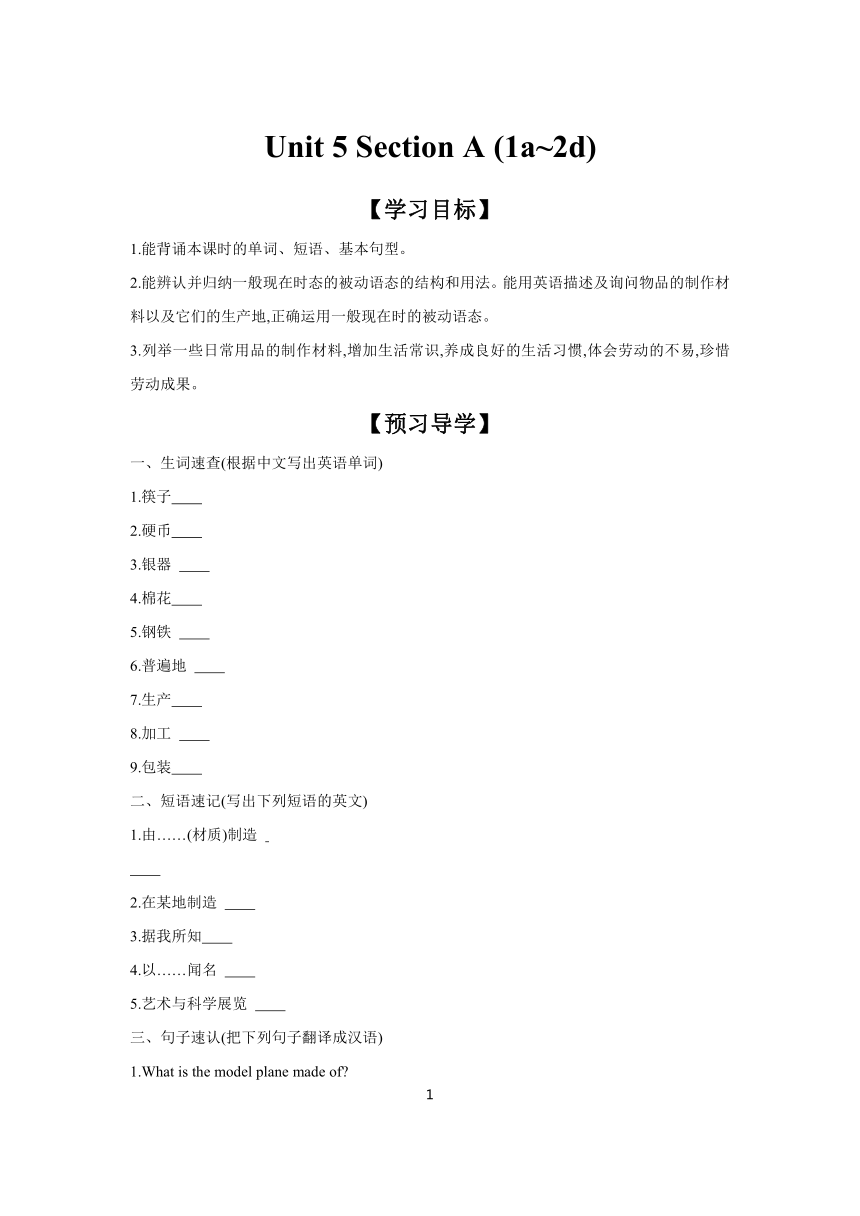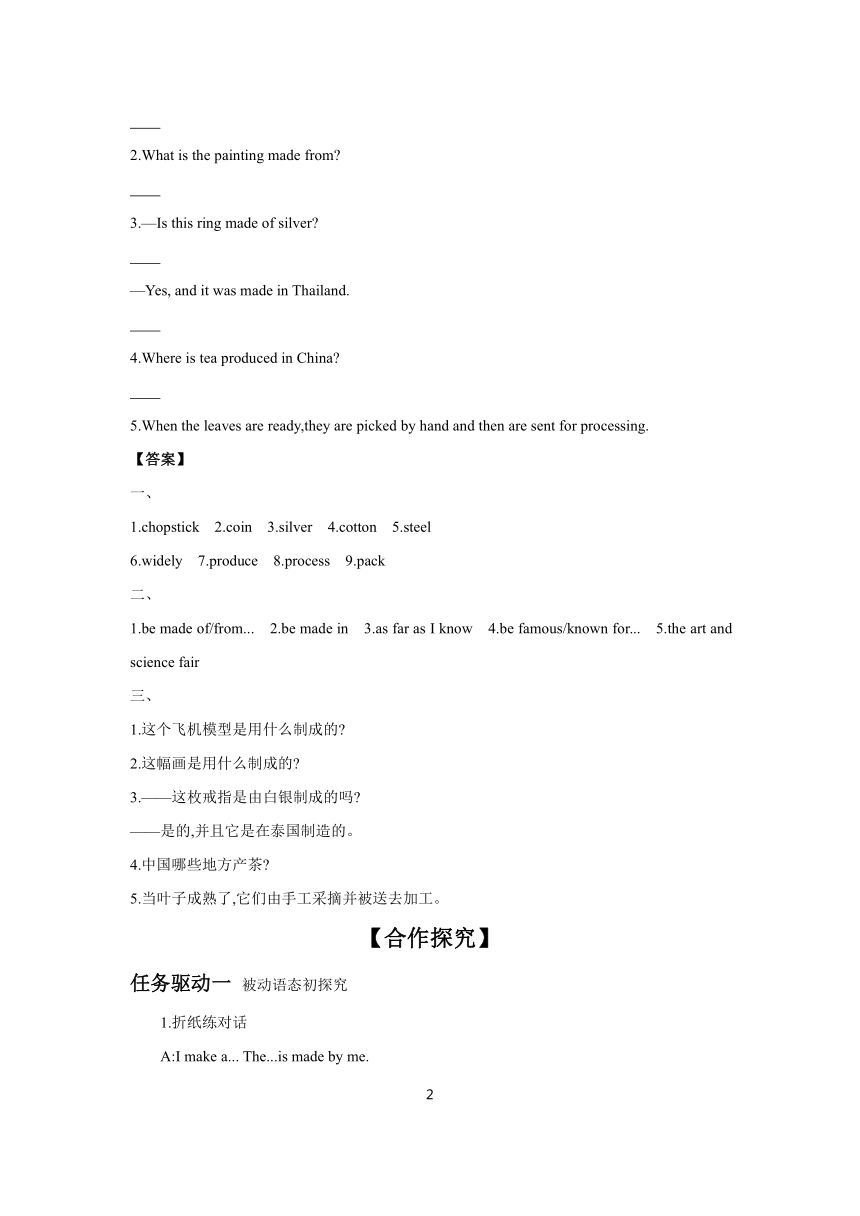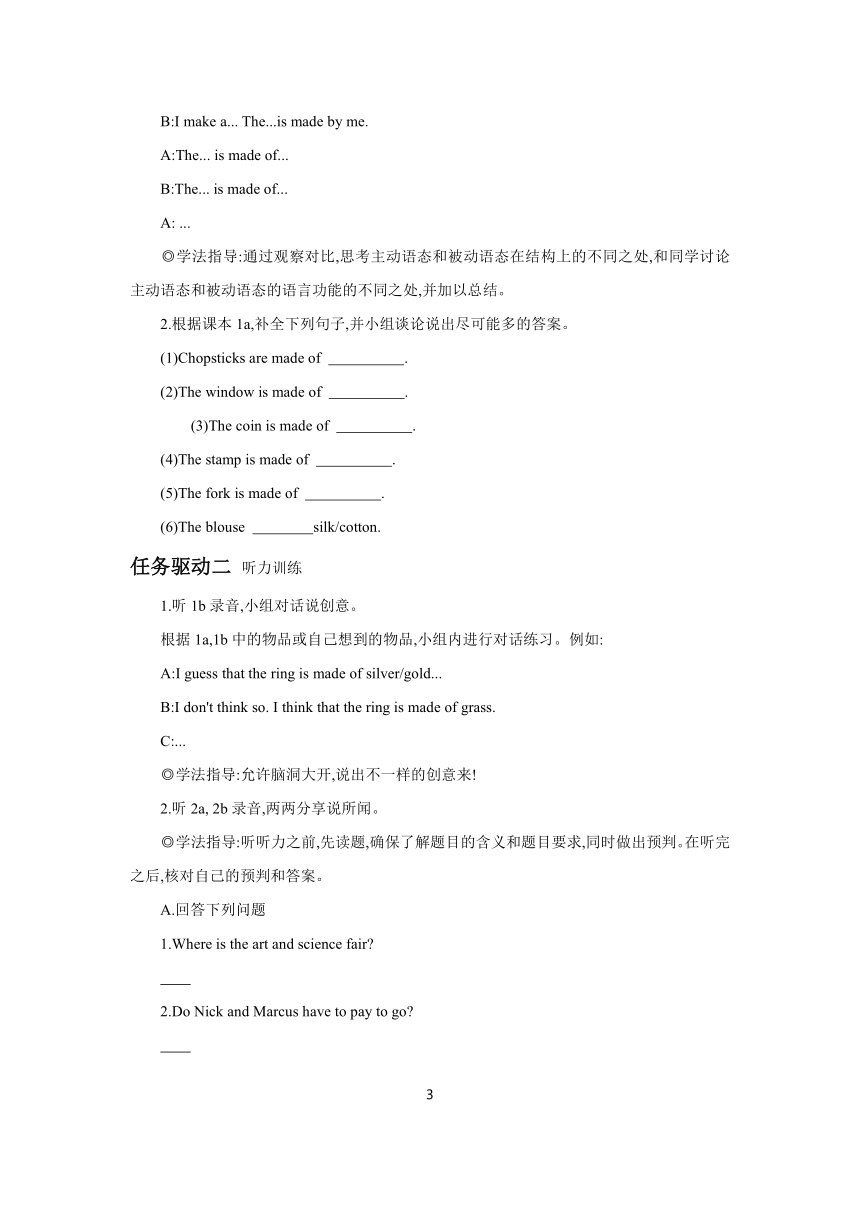Unit 5 What are the shirts made of? Section A (1a~2d) 学案 初中英语人教版九年级全一册(含答案)
文档属性
| 名称 | Unit 5 What are the shirts made of? Section A (1a~2d) 学案 初中英语人教版九年级全一册(含答案) |  | |
| 格式 | docx | ||
| 文件大小 | 24.7KB | ||
| 资源类型 | 教案 | ||
| 版本资源 | 人教新目标(Go for it)版 | ||
| 科目 | 英语 | ||
| 更新时间 | 2024-02-21 16:40:35 | ||
图片预览



文档简介
Unit 5 Section A (1a~2d)
【学习目标】
1.能背诵本课时的单词、短语、基本句型。
2.能辨认并归纳一般现在时态的被动语态的结构和用法。能用英语描述及询问物品的制作材料以及它们的生产地,正确运用一般现在时的被动语态。
3.列举一些日常用品的制作材料,增加生活常识,养成良好的生活习惯,体会劳动的不易,珍惜劳动成果。
【预习导学】
一、生词速查(根据中文写出英语单词)
1.筷子
2.硬币
3.银器
4.棉花
5.钢铁
6.普遍地
7.生产
8.加工
9.包装
二、短语速记(写出下列短语的英文)
1.由……(材质)制造
2.在某地制造
3.据我所知
4.以……闻名
5.艺术与科学展览
三、句子速认(把下列句子翻译成汉语)
1.What is the model plane made of
2.What is the painting made from
3.—Is this ring made of silver
—Yes, and it was made in Thailand.
4.Where is tea produced in China
5.When the leaves are ready,they are picked by hand and then are sent for processing.
【答案】
一、
1.chopstick 2.coin 3.silver 4.cotton 5.steel
6.widely 7.produce 8.process 9.pack
二、
1.be made of/from... 2.be made in 3.as far as I know 4.be famous/known for... 5.the art and science fair
三、
1.这个飞机模型是用什么制成的
2.这幅画是用什么制成的
3.——这枚戒指是由白银制成的吗
——是的,并且它是在泰国制造的。
4.中国哪些地方产茶
5.当叶子成熟了,它们由手工采摘并被送去加工。
【合作探究】
任务驱动一 被动语态初探究
1.折纸练对话
A:I make a... The...is made by me.
B:I make a... The...is made by me.
A:The... is made of...
B:The... is made of...
A: ...
◎学法指导:通过观察对比,思考主动语态和被动语态在结构上的不同之处,和同学讨论主动语态和被动语态的语言功能的不同之处,并加以总结。
2.根据课本1a,补全下列句子,并小组谈论说出尽可能多的答案。
(1)Chopsticks are made of .
(2)The window is made of .
(3)The coin is made of .
(4)The stamp is made of .
(5)The fork is made of .
(6)The blouse silk/cotton.
任务驱动二 听力训练
1.听1b录音,小组对话说创意。
根据1a,1b中的物品或自己想到的物品,小组内进行对话练习。例如:
A:I guess that the ring is made of silver/gold...
B:I don't think so. I think that the ring is made of grass.
C:...
◎学法指导:允许脑洞大开,说出不一样的创意来!
2.听2a, 2b录音,两两分享说所闻。
◎学法指导:听听力之前,先读题,确保了解题目的含义和题目要求,同时做出预判。在听完之后,核对自己的预判和答案。
A.回答下列问题
1.Where is the art and science fair
2.Do Nick and Marcus have to pay to go
3.What is the model plane made of
4.What is the painting made from
B.分享说见闻
以活动2a、2b的信息及听力原文为参考,假设你是Nick,以第一人称的身份,用自己的话复述Nick的所见所闻。先小组内练习,再自愿展示。例如:
At the art and science fair, I saw... It is made of/from... It is made by...
任务驱动二 角色扮演试说茶
1.自读2d对话,回答下面的问题。
(1)Where is tea produced in China
(2)Which cities are widely known for their tea
(3)How is tea produced
2.大声朗读2d中的对话,读熟后与同伴结对练习,分角色表演对话。
◎学法指导:归纳一般现在时态被动语态的结构和用法。被动语态的构成:被动语态是由“助动词be +过去分词”构成的,过去分词保持不变,而所有的变化,即人称、数、时态的变化,都体现在助动词be的变化上。
【答案】
任务驱动一
(1)wood/ silver/bamboo
(2)wood and glass
(3)steel/ silver/gold
(4)paper
(5)steel/ silver/gold
(6)is made of
任务驱动二
1.Outside the science museum.2.No, they don't.3.It is made of used wood and glass.4.It's made of grass, leaves and flowers.
任务驱动三
(1)In many different areas.
(2)Anxi and Hangzhou.
(3)Tea plants are grown on the sides of mountains. When the leaves are ready, they are picked by hand and then are sent for processing.
【知识超市】
[命题点一]
Where is tea produced in China 中国什么地方生产茶叶
◎观察思考:
1.Hard work produces success.辛勤的劳动带来成功。
2.Buy some native produce. 买些土特产。
3.The product is sold both at home and overseas. 这个产品在国内外都有销售。
◎用法总结:produce作为动词, 意为“生产; 产生; 提出; 出版; 演出; 导致”。produce作为名词, 意为“产品,农业生产的产品”。product作为名词, 意为“工业生产的产品”。
对点自测
用括号内所给单词的适当形式填空
1.People like to buy natural (produce).
2.That's the (produce)of his work.
3.The workers are (produce)cars in the factory.
[命题点二]
Is it made of silver 它是由银制成的吗
◎观察思考:
1.The paper is made from wood.纸是木头做的。
2.The car is made in Shanghai. 这辆车是在上海制造的。
3.Our class is made up of six groups. 我们班是由六个小组组成的。
◎用法总结:be made of...意为“由……制成的”,表示制成成品后,仍可看出原材料是什么,制作过程仅发生物理变化。be made from意为“由……制成的”表示制成的东西完全失去了原材料的外形或特征,或原材料在制作过程中发生化学变化,在成品中已无法辨认。be made up of...意为“用……构成或组成的”,指人、物皆可,指结构成分。be made in +地点 意为“在……(地方)制成”。 be made by 意为“被(某人)……制成”。
对点自测
用be made of/from/by填空
1.Bread wheat.
2.These T-shirts cotton. They are comfortable to wear.
3.These cakes my sister last night.
【答案】
命题点一
对点自测
1.produce 2.product 3.producing
命题点二
对点自测
1.is made from 2.are made of 3.were made by
2
【学习目标】
1.能背诵本课时的单词、短语、基本句型。
2.能辨认并归纳一般现在时态的被动语态的结构和用法。能用英语描述及询问物品的制作材料以及它们的生产地,正确运用一般现在时的被动语态。
3.列举一些日常用品的制作材料,增加生活常识,养成良好的生活习惯,体会劳动的不易,珍惜劳动成果。
【预习导学】
一、生词速查(根据中文写出英语单词)
1.筷子
2.硬币
3.银器
4.棉花
5.钢铁
6.普遍地
7.生产
8.加工
9.包装
二、短语速记(写出下列短语的英文)
1.由……(材质)制造
2.在某地制造
3.据我所知
4.以……闻名
5.艺术与科学展览
三、句子速认(把下列句子翻译成汉语)
1.What is the model plane made of
2.What is the painting made from
3.—Is this ring made of silver
—Yes, and it was made in Thailand.
4.Where is tea produced in China
5.When the leaves are ready,they are picked by hand and then are sent for processing.
【答案】
一、
1.chopstick 2.coin 3.silver 4.cotton 5.steel
6.widely 7.produce 8.process 9.pack
二、
1.be made of/from... 2.be made in 3.as far as I know 4.be famous/known for... 5.the art and science fair
三、
1.这个飞机模型是用什么制成的
2.这幅画是用什么制成的
3.——这枚戒指是由白银制成的吗
——是的,并且它是在泰国制造的。
4.中国哪些地方产茶
5.当叶子成熟了,它们由手工采摘并被送去加工。
【合作探究】
任务驱动一 被动语态初探究
1.折纸练对话
A:I make a... The...is made by me.
B:I make a... The...is made by me.
A:The... is made of...
B:The... is made of...
A: ...
◎学法指导:通过观察对比,思考主动语态和被动语态在结构上的不同之处,和同学讨论主动语态和被动语态的语言功能的不同之处,并加以总结。
2.根据课本1a,补全下列句子,并小组谈论说出尽可能多的答案。
(1)Chopsticks are made of .
(2)The window is made of .
(3)The coin is made of .
(4)The stamp is made of .
(5)The fork is made of .
(6)The blouse silk/cotton.
任务驱动二 听力训练
1.听1b录音,小组对话说创意。
根据1a,1b中的物品或自己想到的物品,小组内进行对话练习。例如:
A:I guess that the ring is made of silver/gold...
B:I don't think so. I think that the ring is made of grass.
C:...
◎学法指导:允许脑洞大开,说出不一样的创意来!
2.听2a, 2b录音,两两分享说所闻。
◎学法指导:听听力之前,先读题,确保了解题目的含义和题目要求,同时做出预判。在听完之后,核对自己的预判和答案。
A.回答下列问题
1.Where is the art and science fair
2.Do Nick and Marcus have to pay to go
3.What is the model plane made of
4.What is the painting made from
B.分享说见闻
以活动2a、2b的信息及听力原文为参考,假设你是Nick,以第一人称的身份,用自己的话复述Nick的所见所闻。先小组内练习,再自愿展示。例如:
At the art and science fair, I saw... It is made of/from... It is made by...
任务驱动二 角色扮演试说茶
1.自读2d对话,回答下面的问题。
(1)Where is tea produced in China
(2)Which cities are widely known for their tea
(3)How is tea produced
2.大声朗读2d中的对话,读熟后与同伴结对练习,分角色表演对话。
◎学法指导:归纳一般现在时态被动语态的结构和用法。被动语态的构成:被动语态是由“助动词be +过去分词”构成的,过去分词保持不变,而所有的变化,即人称、数、时态的变化,都体现在助动词be的变化上。
【答案】
任务驱动一
(1)wood/ silver/bamboo
(2)wood and glass
(3)steel/ silver/gold
(4)paper
(5)steel/ silver/gold
(6)is made of
任务驱动二
1.Outside the science museum.2.No, they don't.3.It is made of used wood and glass.4.It's made of grass, leaves and flowers.
任务驱动三
(1)In many different areas.
(2)Anxi and Hangzhou.
(3)Tea plants are grown on the sides of mountains. When the leaves are ready, they are picked by hand and then are sent for processing.
【知识超市】
[命题点一]
Where is tea produced in China 中国什么地方生产茶叶
◎观察思考:
1.Hard work produces success.辛勤的劳动带来成功。
2.Buy some native produce. 买些土特产。
3.The product is sold both at home and overseas. 这个产品在国内外都有销售。
◎用法总结:produce作为动词, 意为“生产; 产生; 提出; 出版; 演出; 导致”。produce作为名词, 意为“产品,农业生产的产品”。product作为名词, 意为“工业生产的产品”。
对点自测
用括号内所给单词的适当形式填空
1.People like to buy natural (produce).
2.That's the (produce)of his work.
3.The workers are (produce)cars in the factory.
[命题点二]
Is it made of silver 它是由银制成的吗
◎观察思考:
1.The paper is made from wood.纸是木头做的。
2.The car is made in Shanghai. 这辆车是在上海制造的。
3.Our class is made up of six groups. 我们班是由六个小组组成的。
◎用法总结:be made of...意为“由……制成的”,表示制成成品后,仍可看出原材料是什么,制作过程仅发生物理变化。be made from意为“由……制成的”表示制成的东西完全失去了原材料的外形或特征,或原材料在制作过程中发生化学变化,在成品中已无法辨认。be made up of...意为“用……构成或组成的”,指人、物皆可,指结构成分。be made in +地点 意为“在……(地方)制成”。 be made by 意为“被(某人)……制成”。
对点自测
用be made of/from/by填空
1.Bread wheat.
2.These T-shirts cotton. They are comfortable to wear.
3.These cakes my sister last night.
【答案】
命题点一
对点自测
1.produce 2.product 3.producing
命题点二
对点自测
1.is made from 2.are made of 3.were made by
2
同课章节目录
- Unit 1 How can we become good learners.
- Section A
- Section B
- Unit 2 I think that mooncakes are delicious!
- Section A
- Section B
- Unit 3 Could you please tell me where the restroom
- Section A
- Section B
- Unit 4 I used to be afraid of the dark.
- Section A
- Section B
- Unit 5 What are the shirts made of?
- Section A
- Section B
- Review of Units 1-5
- Unit 6 When was it invented?
- Section A
- Section B
- Unit 7 Teenagers should be allowed to choose their
- Section A
- Section B
- Unit 8 It must belong to Carla.
- Section A
- Section B
- Unit 9 I like music that I can dance to.
- Section A
- Section B
- Unit 10 You're supposed to shake hands.
- Section A
- Section B
- Review of Units 6-10
- Unit 11 Sad movies make me cry.
- Section A
- Section B
- Unit 12 Life is full of the unexpected
- Section A
- Section B
- Unit 13 We're trying to save the earth!
- Section A
- Section B
- Unit 14 I remember meeting all of you in Grade 7.
- Section A
- Section B
- Review of Units 11-14
